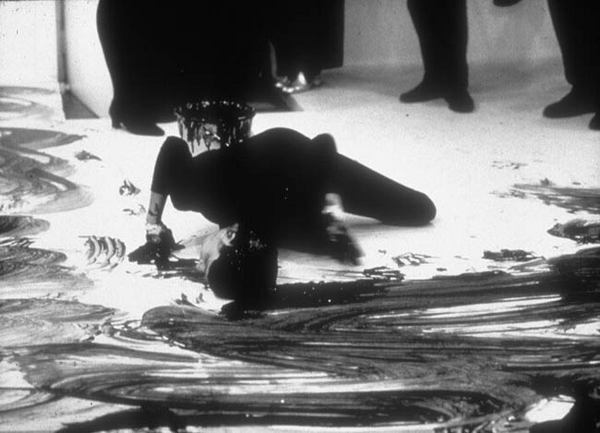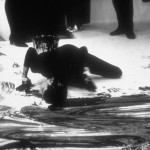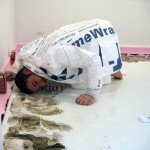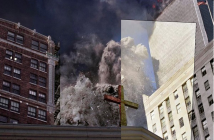The Beginning of the End
All good things must come to an end. Postmodernism has had its run, but perhaps the time has come to wonder if we are not entering some sort of endgame for the experiment, a critical mass of frustration and dissent that might ultimately result in a new form of art. It has happened before, and if there is one thing history is good at, it's repeating itself.
One of the key characteristics of political and social change is that of the endgame, in which the obvious and impending evolution is clearly visible to all sides who react in distinct and predictable ways. As change approaches, those with vested interests in the current state of things react by tightening their position, entrenching and even making their positions more strict as a way to fend off the inevitable.
For artists in the Modern era, this can be seen in the competition to create the ultimate Minimalist piece, and the resulting frustration and ultimate radicalization of those who could not create within the ever-tightening definitions of true art. Anthony Haden-Guest looks at that moment in his book True Colors, which reads like a gossip column extended to a novel. Still, it's worth quoting him at length:
When Frank Stella made his black "pinstripe" paintings in the early sixties, he described them as "a flat surface with paint on it -- nothing more." He had shot the swan of allegory. You couldn't go back again. These were the "Last Paintings." Stella's contemporaries, the Minimalists -- like Donald Judd, Carl Andre, Sol LeWitt and Dan Flavin -- made objects from with the fat had been boiled, and they were competitive about this. Carl Andre said to an interviewer, "Donald Judd is a fine sculptor, but he deals with materials in an almost painterly way." No compliment intended. "My sculptures are masses and their subject is matter."
[...]
It is a tribute to the grip the Minimalists exerted on the American art world that the movement didn't just wash away, the way Abstract Expressionism had. It was as if there was so much repressed energy in those obdurate shapes that they had to explode. In a brief, extraordinary period toward the end of the 1960s the art world went off like one of those fireworks that send other fireworks zinging onward in all directions. To describe the time, you have to follow the trajectory of one story, return to the point of explosion, follow another, go back, and so on, until you are done [...]1
Haden-Guest's use of the word explosion is hardly hyperbole, as the following decade saw the emergence of many new art movements, each intended to strike back at the perceived end of art that Modernism, as exemplified by Minimalism, was striving for. Thus emerged Conceptual Art and Performance Art as two forms in which all that had been banished from art could re-assert their importance: irony, emotion, humor, politics, the body, the world represented, recast, mirrored, echoed, debated, covered in bodily fluids and laid bare. The art of early Postmodernism looks to the contemporary eye as a kind of flailing, a frustration that can no longer be contained. It demanded simultaneously that art could not be at its end, and that the art of the future would not constrain itself to the absolutes of Minimalism. It denied manifestos and mocked everything that took itself too seriously, even as it took its own mockery too seriously.
The Postmodern Strategy
By any definition, Postmodernism exists only in juxtaposition to Modernism. The central premise of the "movement" is that of critique. The fracturing of Modernism opened the door for a number of artists who had previously been excluded to now engage in a public critic of the system that, for so long had kept them on the sidelines. The instinct to critique this past exclusion became the central theme for many artists.
Postmodern critique comes in many forms, but the most common seems to be the act of co-opting the ideas of the perceived oppressor and subverting them. Anyone who has read this far must be aware that the most common villain for Postmodern art has been the white male, his dominance over all of Modern and pre-Modern art history (as well as world history generally) too tempting and worthy a subject to ignore. Artists have found ways to critique every aspect of the male gaze, the white gaze, and the hetero-normative gaze. These critiques have often involved the reenacting of some facet of the historical oppression, subverting this past by remaking it in a new context.
There are far too many examples of this strategy in action to list here, but perhaps the two most obvious are by Janine Antoni from the early 1990s. The first, Gnaw from 1992, exemplifies the Postmodern strategy fully. Here, she has created two cubes of chocolate and lard, which she has then bitten and chewed, leaving her teeth marks. The pieces of chocolate and large removed by her mouth have been cast into a heart-shaped Valentine's Day chocolate package, and tubes of lipstick.
In this work we see the layers of critique that exemplify both Antoni's work and the larger Postmodern diaspora. The large cubes invoke the cubes of Donald Judd (a hated Minimalist) while also invoking the Feminist themes of body image and pleasure. Her recasting of the regurgitated pieces of lard and chocolate into items of pleasure and beauty further extend the references.
In The Contingent Object of Contemporary Art, Martha Buskirk writes of Gnaw:
Antoni articulates a complex relationship to an artistic heritage that, by her own description, "defines me as an artist and ... excludes me as a woman." It is a heritage that encompasses sculptural forms as well as materials. One of the remarkable features of Antoni's use of chocolate and of lard is that these materials were hardly new to the art world when she used them during the 1990s [...]2
Buskirk goes on to point out the connections to Joseph Beuys and Dieter Roth, two references that extended her critique beyond the Minimalists to a more generalized and male version of sculptural history.
Similarly, Antoni's Loving Care from 1991 exemplifies the multilayered critique strategy. As she paints/mops the floor of a gallery with her hair, dipping her head into a bucket of Loving Care hair dye, she melds both the male privilege of Abstract Expressionism with the lowly woman's work of mopping. It is a thorough, damning and complex critique.
Yet, it is important to note that the kind of critique made her by Antoni (as but one example by a large number of artists) is based in a recognition and understanding of the inherent meaning of the elements being referenced, particularly their negative connotations. Without an understanding of the great shift in art that came about because of a frustration with Minimalism, the cubes of chocolate and lard are just cubes. Without an understanding of the macho "Action Painter" underpinnings of AbEx, Loving Care is, at best, a feminist critique of beauty expectations.
In a broader sense, Postmodern art emerged from a frustration with the diminishing possibilities of Modernism, and codified into a "movement" of critique and reference. Artists found themselves expected to have multiple layers of opinion and reference in each new piece, and thus began the mining of art and social history for any fraction of a reference, no matter how insignificant, that was worthy of critique.
Alongside these artists who have embraced the Postmodern "tradition" of critique are a number of artists who have no interest in that mode of artistic creation. Some look on bemusedly, or in confusion or frustration, as art and social politics seem to blur more and more. These artists make work that, in some ways, continues the Modernist project in original and inspiring ways. They don't deny the impact of Postmodernism, but they choose to perpetuate the aspects of Modernism that they value, including aestheticism and beauty, form and mark making, color, formalism, humanism, and many other practices that relate to both form and craft.
Interestingly, as Postmodernism has fractured and fractured over time, all forms and strategies have become acceptable. One might easily find a figurative painting, a Postmodern video critique, and the remnants of a performance all in a single show. Any critique of Modernism that once fired the "movement" is now gone, and yet the practice remains.
The Critical Mass
In a general sense, the entire conversation around art has moved from one of value to one of dialogue. Most of the Modernist movements aspired to some form of idealism, usually contained in a manifesto or centralized text. Even after Modernism crossed the Atlantic and took root in America, the writing of Clement Greenberg and others acted as "The Word" to be followed.
In The Painted Word, Tom Wolfe writes:
I am willing [...] to predict that in the year 2000, when the Metropolitan or the Museum of Modern Art puts on the great retrospective exhibition of American Art 1945-75, the three artists who will be featured, the three seminal figures of the era, will not be Pollock, de Kooning and Johns -- but Greenberg, Rosenberg, and Steinberg. Up on the walls will be huge copy blocks, the protean passages of the period... a little fuliginous flatness" here... a little "action painting" there... and some of that "all great art is about art" just beyond. Beside them will be small reproductions of the work of the leading illustrators of the Word from that period [...]3
Perhaps the greatest break that artists made with Modernism was the idea that their work was valued against a larger ideal. In one sense, this freed artists to make works of diverse origins, theoretical underpinnings and conceptual or aesthetic frameworks, but it also made it much harder for both the art critic and art audience to figure out how to engage with the work. Contemporary critic Lane Relyea actually seems to pine for the days when art could be judged good or bad by how well it illustrated "The Word" when he writes:
Disunity threatens modernism, whereas unity is the threat perceived by postmodernism.4
No fan of Postmodernism, he writes one paragraph later:
It's no coincidence that discourse becomes the dominant art medium once all artists start going to college to get MFAs in the '60s.
The fundamental complaint from artists, critics and audience alike seems to be that contemporary art is just too.... squishy. Every artist can define their own system of evaluation, triangulating references, quotations and associations to create a frame of reference that puts their ideas into context, preferably a context in which their work can be seen in the best light.
Some artists seem more than aware of this triangulation problem, and a few even revel in it. In an interview in Big RED issue #25, Lee Walton said of his practice:
After being referred to as a Conceptual Artist, Performance Artist and other terms, I started to get frustrated. The more I learned about these practices, the more I realized that I am not them. For example, I take Sol Lewitt's "Rules on Conceptual Art" very seriously and therefore cannot consider myself a conceptual artist. I have too much respect for those rules.
If I was a painter... I would paint.
As for the term "performance artist", I could never grasp what that exactly that is? I don't think if you're in front or behind a camera should determine if you are performing or not. That seems ridiculous. My relationship to my body is not any different than the tip of my pencil. It's just a tool. When you make a drawing, nobody watches the activity of the tip of the pencil and considers that a "performance." Jumping and sliding all around...
The term, "Experientialist" I like.
Its not a matter of comfort, in fact, its about being uncomfortable. Instead of lying in bed and knowing exactly what I am and what I do, now I lay in bed and wonder what the fuck an Experientialist is? Once I accept a title I have a job description. No thanks.
For a Postmodern artist, Walton's approach makes complete sense. If the rules of one category of art don't fit, and those of another are too loose, make up a third. Move the goal posts, change the rules, define a new paradigm. When done by one or two artists, this approach can be an intriguing challenge. When done by thousands of artists, all artists... it's no wonder people get frustrated. As a critic, Lane Relyea (and many of the others decrying the Critical Mess) want a return to a more structured version of art because it makes it easier to define what is "good" and what is "bad." More generally, the frustration with the flexibility of Postmodernism is, at its core, a hope that things will be easier to understand.
Ourobouros
The Postmodern critique strategy works, to a point, because it comes from a recognizably human trait. Who, as children, did not take the words of their parents and peers and hurl them back with a tone of mocking mimicry? Words, as ideas spoken, can have their power inverted through the subversion of reflection, distorted into new meaning by a change of tone or context. Art of the Postmodern era has increasingly relied on this strategy, and here the telling signs of the endgame of Postmodernism begin to betray themselves.
Forty-plus years after the fracturing of Modernism, both the critique strategy and subjects have begun to turn inside out. A very telling piece -- one of many, really -- is Andrew Mowbray's Just For Men which was performed at the Boston Center for the Arts in 2007. In this piece, Mowbray re-made Janine Antoni's Loving Care. The work contains a number of layered references, all built on Antoni's initial critique of the male gaze and the masculine history of art. By recreating the piece with a single shift in context, his maleness, he re-invests the original work with a broader, more open-ended questioning of masculinity in a a post-feminist era.
Mowbray's piece is a very interesting performance, especially because of how clearly it comes from this moment in Postmodern history. The subjects of the Antoni's original critique are too far in the past to be relevant today, in fact most were made before Mowbray was born, so art history as a subject for comment and reinterpretation is becoming more and more derived from the earlier Postmodern works. As time marches on, more and more work will be created from this history.
Mowbray's piece is not unique in its approach, nor is it a failed work of art. In fact, it is an ideal example of the state of Postmodern art, which has become thoroughly self-consuming. As the kinds of ideas, strategies and discourse that are acceptable as artistic practice has expanded and evolved, artists seem to be looking for something, anything to point to as a constant. Art history has always been that source. Yet, just as the Modernists rushed toward the "Last Painting" in that endgame, I seems that we are now involved in another endgame.
Where this endgame will lead is anyone's guess, but the same frustration that "exploded" in the early 1970s seems to be growing today. The political and social context in which art is created is fundamentally different, and therefore the responses to this frustration will certainly be different, but what will they be? Postmodernism has become the "movement" that embraces all forms of art, so what kind of work could be made this isn't Postmodern? The frustration with the floating context of contemporary art is central to the endgame, but where will that lead? Will we return, as Lane Relyea and others appear to wish, to a more structured and hierarchical form of artistic practice? Or will things continue to fracture, creating local "Yokelist" schools of thought in the face of an expanding and global art system?
It could be none of the above. Perhaps this endgame won't end in an explosion, but a fizzle. Time will tell.
- Janine Antoni, Loving Care, 1993
- Andrew Mowbray, Just For Men, 2007
[1] - Anthony Haden-Guest, True Colors, The Atlantic Monthly Press, 1996. p.24
[2] - Martha Buskirk, The Contingent Object of Contemporary Art, MIT Press, 2003. pp. 139-140
[3] - Tom Wolfe, Painted Word, Bantam Books, 1975. pp. 118-119
[4] - Lane Relyea, "All Over And At Once", Critical Mess, Raphael Rubenstein, editor. Hard Press editions, 2006. Originally published in X-TRA, Fall 2003.
Mowbray image courtesy of the artist's website.
Antoni image found here.





